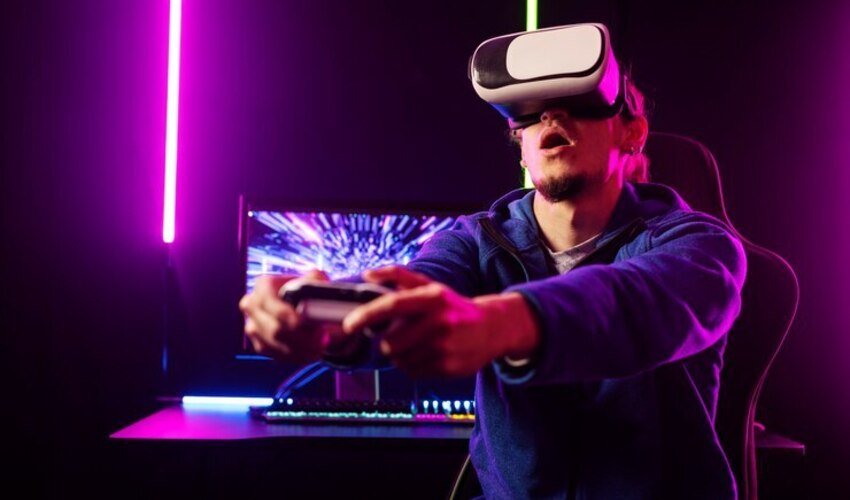Virtual reality (VR) has grown rapidly in recent years. It has changed the way we play, learn, and work. One key innovation making VR better is Zero Latency Virtual Reality. This technology removes delays between user actions and system responses. As a result, VR experiences become smoother and more immersive. But what exactly is zero latency VR? How does it work? And why is it such a game-changer?
What is Zero Latency Virtual Reality?
Zero Latency Virtual Reality refers to a VR system with no noticeable delay. In regular VR, there is often a small lag between an action and its display. This delay can cause discomfort and break the sense of immersion. Zero latency VR eliminates this lag, creating a more realistic and engaging experience.
The goal is to reduce latency to less than 20 milliseconds. At this speed, the human brain cannot detect any delay. This creates a seamless connection between the user’s actions and what they see or hear. As a result, the virtual world feels natural and real.
How Does Zero Latency VR Work?
Achieving zero latency in VR requires advanced technology. Several components work together to make this possible:
-
High-Performance Processors: Powerful processors handle vast amounts of data quickly. They ensure that the system responds instantly to user inputs.
-
Advanced Sensors: Sensors track movements in real time. These include gyroscopes, accelerometers, and cameras.
-
Optimized Software: Efficient software algorithms process and display data with minimal delay.
-
Low-Latency Displays: Modern VR headsets use high-refresh-rate displays. These screens reduce motion blur and improve responsiveness.
-
Fast Connectivity: Wireless systems use technologies like Wi-Fi 6 and 5G. These networks transmit data faster, reducing lag.
Together, these elements create a smooth, real-time VR experience.
Applications of Zero Latency Virtual Reality
While gaming is the most popular use of VR, zero latency technology has applications beyond entertainment. Let’s explore its impact across various fields:
1. Gaming and Entertainment
Gaming has been transformed by zero latency VR. Traditional VR games sometimes suffer from motion sickness caused by lag. Zero latency systems solve this issue, making games more enjoyable.
In multiplayer games, real-time interaction is crucial. Zero latency VR allows players to react instantly to opponents’ moves. This enhances competitiveness and engagement.
VR arcades like Zero Latency VR centers offer immersive group experiences. Players team up to fight zombies or solve puzzles in large virtual spaces. These experiences feel lifelike thanks to the absence of lag.
2. Education and Training
Education has greatly benefited from VR technology. With zero latency VR, learning becomes more interactive. Students can explore historical sites, conduct virtual science experiments, and practice new skills.
Professional training also uses VR simulations. Pilots, surgeons, and firefighters train in realistic environments without real-world risks. Immediate feedback helps learners improve faster.
3. Healthcare and Therapy
Healthcare professionals use zero latency VR for various purposes. Surgeons practice procedures in detailed virtual models of the human body. Therapists use VR to treat anxiety, PTSD, and phobias.
With zero latency, these treatments feel more authentic. Patients engage better with the virtual environment, making therapy more effective.
4. Manufacturing and Design
In manufacturing, zero latency VR helps engineers visualize and test products. Designers can walk through virtual prototypes and make changes instantly. This speeds up development and reduces costs.
Automotive companies use VR to test vehicle designs before building physical models. Architects use it to present 3D building plans to clients.
5. Remote Collaboration
Remote work has become more common, and VR is playing a role in this shift. Zero latency VR allows teams to meet in virtual offices. They can brainstorm, present ideas, and collaborate as if they were in the same room.
Global companies use this technology to connect employees across continents. This improves communication and strengthens team relationships.
The Impact of Zero Latency VR on Gaming
Gaming remains the most exciting application of zero latency VR. Here’s how it enhances the gaming experience:
-
Better Immersion: Players feel like they are truly inside the game world. Real-time responses make everything more believable.
-
Improved Performance: Fast feedback helps gamers react quickly. In competitive games, this can make a big difference.
-
Reduced Motion Sickness: Lag in VR often causes dizziness. Zero latency VR minimizes this issue, making gaming more comfortable.
-
Enhanced Multiplayer Interaction: In multiplayer games, quick communication and response are essential. Zero latency ensures smoother collaboration and competition.
VR developers are continuously innovating to make games even more immersive. As zero latency technology improves, we can expect more realistic and engaging games.
Challenges in Achieving Zero Latency VR
Despite its benefits, achieving zero latency in VR is challenging. Here are some key obstacles:
-
Hardware Limitations: Creating high-performance, low-latency hardware is costly. Devices need powerful processors and advanced sensors.
-
Wireless Communication Issues: Wireless VR relies on fast, stable connections. Network interference can cause delays.
-
Software Optimization: Developers must write efficient code to reduce processing time.
-
Cost Barriers: High-quality zero latency VR systems are expensive. Making them affordable for consumers remains a challenge.
Researchers and companies continue to address these issues. As technology improves, zero latency VR will become more accessible.
The Future of Zero Latency Virtual Reality
The future of zero latency VR looks promising. Here are some trends we might see in the coming years:
-
Improved Hardware: More powerful processors and advanced sensors will enhance performance.
-
Better Wireless Technology: Faster networks like 6G could make wireless VR even smoother.
-
AI Integration: Artificial intelligence will optimize VR environments, making them more responsive.
-
Wider Adoption: As costs decrease, more industries will adopt zero latency VR.
In gaming, we can expect more realistic worlds and lifelike characters. In education, students might attend virtual classrooms from anywhere. In healthcare, doctors could perform complex surgeries remotely with real-time VR assistance.
Conclusion
Zero Latency Virtual Reality is more than just a gaming upgrade. It’s a transformative technology with applications across many fields. By eliminating lag, VR becomes more immersive, comfortable, and engaging. From entertainment to healthcare, this innovation is reshaping how we interact with digital environments.
As researchers overcome current challenges, zero latency VR will become more widespread. The future promises even more realistic and seamless virtual experiences. For gamers, professionals, and learners alike, zero latency VR is truly a game-changer.
Read Dive is a leading technology blog focusing on different domains like Blockchain, AI, Chatbot, Fintech, Health Tech, Software Development and Testing. For guest blogging, please feel free to contact at readdive@gmail.com.





